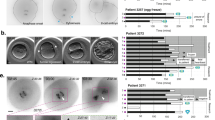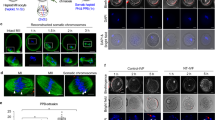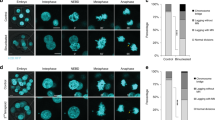Abstract
IT has been reported that cytochalasin B can prevent cytokinesis without influencing nuclear division1. Cells undergoing mitosis in the presence of cytochalasin B become binucleate and occasionally, with prolonged incubation, multinucleate1–3. Treated cells generally resume cleavage upon removal from cytochalasin and reculturing. It has been shown that many of the binucleate cells produced in a BHK21 cell line will develop as tetraploids upon reculturing in fresh medium4,5. Here I report the treatment of cleaving mouse eggs with cytochalasin and the establishment of tetraploidy in mouse embryos.
This is a preview of subscription content, access via your institution
Access options
Subscribe to this journal
Receive 51 print issues and online access
$199.00 per year
only $3.90 per issue
Buy this article
- Purchase on Springer Link
- Instant access to full article PDF
Prices may be subject to local taxes which are calculated during checkout
Similar content being viewed by others
References
Carter, S. B., Nature, 213, 261 (1967).
Krishan, A., and Ray-Chaudhuri, R., J. Cell Biol., 43, 618 (1969).
Krishan, A., J. Cell Biol., 54, 657 (1972).
Defendi, V., and Stoker, M. G. P., Nature new Biol., 242, 24 (1973).
Hoehn, H., Sprague, C. A., and Martin, G. M., Expl. Cell Res., 76, 170 (1973).
Graham, C. F., in The Regulation of Mammalian Reproduction (edit. by Segal, S. J., Crozier, R., Corfman, P. A., and Condliffe, P. G.) (C. C. Thomas, Illinois, 1973).
Gamow, E. I., and Prescott, D. M., Expl. Cell Res., 59, 117 (1970).
Samoshkina, N. A., Tsitologia, 10, 856 (1968).
Whitten, W. K., Adv. in Biosciences, 6, 129 (1971).
Schroeder, T. E., Expl. Cell Res., 137, 413 (1969).
Hammer, M. G., Sheridan, J. D., and Estensen, R. D., Proc. Soc. exp. Biol. Med., 136, 1158 (1971).
Ladda, R. L., and Estensen, R. D., Proc. natn. Acad. Sci. U.S.A., 67, 1528 (1970).
Prescott, D. M., Myerson, D., and Wallace, J., Expl. Cell Res., 71, 480 (1972).
Wroblewska, J., Cytogenetics, 10, 199 (1971).
Graham, C. F., in Third Karolinska Symp. on Research Methods in Reproductive Endocrinology (edit. by Diczfalusy, E.), 154 (Karolinska Institutet, Stockholm, 1971).
Beatty, R. A., Parthenogenesis and Polyploidy in Mammalian Development (Cambridge University Press, London, 1957).
Tarkowski, A. K., Acta Theriol., 3, 191 (1959).
Tarkowski, A. K., J. Embryol. expl. Morph., 18, 155 (1967).
Tarkowski, A. K., Nature, 190, 587 (1961).
Mintz, B., J. expl. Zool., 157, 273 (1964).
Author information
Authors and Affiliations
Rights and permissions
About this article
Cite this article
SNOW, M. Tetraploid Mouse Embryos produced by Cytochalasin B during Cleavage. Nature 244, 513–515 (1973). https://doi.org/10.1038/244513a0
Received:
Revised:
Issue Date:
DOI: https://doi.org/10.1038/244513a0
This article is cited by
-
CDK inhibitor SU9516 induces tetraploid blastocyst formation from parthenogenetically activated porcine embryos
Biotechnology Letters (2017)
-
p53 Suppresses Tetraploid Development in Mice
Scientific Reports (2015)
-
Stage-specific gene expression in asynchronous tetraploid mouse embryos formed by fusion of blastomeres and fertilized eggs
Roux's Archives of Developmental Biology (1993)
-
Expression of specific genes in early mouse embryos blocked by cytochalasin
Roux's Archives of Developmental Biology (1987)
-
Effects of cytochalasin B on the cleavage furrow in mouse blastomeres
Roux's Archives of Developmental Biology (1986)
Comments
By submitting a comment you agree to abide by our Terms and Community Guidelines. If you find something abusive or that does not comply with our terms or guidelines please flag it as inappropriate.



